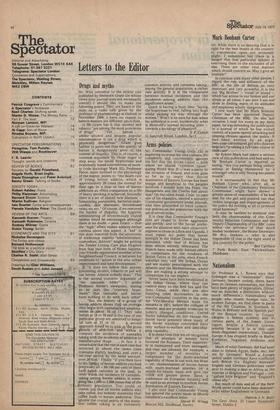Drugs and myths
75 78 Sir: With reference to the article you published by Melmoth Grant (in whose views your journal does not necessarily concur) I should like to make the following points. They are based in the main on a radio talk given by the professor of pharmacology at Oxford, in November 1968. I have no reason to believe matters are different since then.
1) Mr Grant has it that alcohol and 74 tobacco "are among the most poisonous of drugs" . . . "Yet . . . heroin . . . unlike alcohol and despite popular misconception is not a drug which is physically dangerous." Grant goes further to point out that the quality of heroin is dangerously poor in the context of illegality. This is, of course, a common argument by those eager to strip away the social hypocrisies and irrationally based conventions of society (vide Sociology Mark III). Professor Paton, more inclined to the physiology of the matter, points to "the death-rate of young heroin addicts, which is approximately 20 times the normal for their age. In a year or two of heroin addiction an effect comparison to a life of heavy smoking is achieved. Secondly there is a set of almost new diseases — fulminating pneumonia, bacterial endocarditis, skin abscesses, thrombosed veins, etc etc." Of course, if we removed the burden of illegality, the hygienic administering of intravenously routed opiates could be encouraged although there is no doubt — pace Grant — that the "high" effect makes addicts rather careless about this aspect. A "kid" in this state removed from the attentions of traditional experts "administrators, counsellors, doctors" might be getting the Tender Loving Care plus Hygiene from that new form of Homo Sapiens, your friendly regenerated member of the Neighbourhood Council, in between his attentions to "action in the arts, urban improvement and land development." . 2) "It does not follow that anyone consuming alcohol, tobacco or pot will use heroin. Almost nobody does." This is the second common argument of ."the cannabis lobby" I prefer ' Professor Paton's viewpoint, testing as he says the "contrary hypothesis" that cannabis and heroin have nothing to do with each other"
. . .
But the history of a group of heroin addicts shows that an average they begin with cannabis:and amphetamines at about 16 or 17. They take heroin at 18 or 19 and in the case of one particular group are admitted to hospital care at 21 or 22 . . . 4. second approach would be to lobk ,a,t the gross growth of' addiction and 'within it compare the incidence of cannabis taking with the incidence of addition to manufactured drugs . . in fact it is remarkable that the rise in each case has occurred at about the same time (cannabis slightly leading), and, over a ten-year period, by the same amount, over 20-fold." Finally "If you then turn to the hiSt4ry of heroin addicts you find practically all — 80-100 per cent of them ha V 4aken cannabis in the past. In otherwords the incidence bf cannabistaking among heroin addicts is something like 1,000 to 2,000 times that of the kirdinary population. You could, of course, say that all heroin addicts also, take coffee, but nobody maintains that coffee leads to heroin addicition. This ignores the crucial points of the statistics: coffee taking is an extremely
70 71 71 72 74 93 common activity and cannabis taking, among the general population, -a rather rare activity. It is in the comparison between normal incidence and the incidence among addicts that the significance arises." Grant is having a busy time "laying the bogeyman to rest, falling into bogs whilst picking his way through the morass." Won't it be nice for him when his sabbatical is over. Incidentally what is Melmoth's normal lecturing stint — towards a sociology of pleasure? ,
S. P.' Cohen. 51 Sancroft Street, Lpdon,SeU


































 Previous page
Previous page